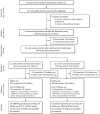Solar drinking water disinfection (SODIS) to reduce childhood diarrhoea in rural Bolivia: a cluster-randomized, controlled trial
- PMID: 19688036
- PMCID: PMC2719054
- DOI: 10.1371/journal.pmed.1000125
Solar drinking water disinfection (SODIS) to reduce childhood diarrhoea in rural Bolivia: a cluster-randomized, controlled trial
Abstract
Background: Solar drinking water disinfection (SODIS) is a low-cost, point-of-use water purification method that has been disseminated globally. Laboratory studies suggest that SODIS is highly efficacious in inactivating waterborne pathogens. Previous field studies provided limited evidence for its effectiveness in reducing diarrhoea.
Methods and findings: We conducted a cluster-randomized controlled trial in 22 rural communities in Bolivia to evaluate the effect of SODIS in reducing diarrhoea among children under the age of 5 y. A local nongovernmental organisation conducted a standardised interactive SODIS-promotion campaign in 11 communities targeting households, communities, and primary schools. Mothers completed a daily child health diary for 1 y. Within the intervention arm 225 households (376 children) were trained to expose water-filled polyethyleneteraphtalate bottles to sunlight. Eleven communities (200 households, 349 children) served as a control. We recorded 166,971 person-days of observation during the trial representing 79.9% and 78.9% of the total possible person-days of child observation in intervention and control arms, respectively. Mean compliance with SODIS was 32.1%. The reported incidence rate of gastrointestinal illness in children in the intervention arm was 3.6 compared to 4.3 episodes/year at risk in the control arm. The relative rate of diarrhoea adjusted for intracluster correlation was 0.81 (95% confidence interval 0.59-1.12). The median length of diarrhoea was 3 d in both groups.
Conclusions: Despite an extensive SODIS promotion campaign we found only moderate compliance with the intervention and no strong evidence for a substantive reduction in diarrhoea among children. These results suggest that there is a need for better evidence of how the well-established laboratory efficacy of this home-based water treatment method translates into field effectiveness under various cultural settings and intervention intensities. Further global promotion of SODIS for general use should be undertaken with care until such evidence is available.
Trial registration: www.ClinicalTrials.govNCT00731497 Please see later in the article for Editors' Summary.
Conflict of interest statement
The authors have declared that no competing interests exist.
Figures




Comment in
-
Solar water disinfection in household settings: hype or hope?PLoS Med. 2009 Aug;6(8):e1000127. doi: 10.1371/journal.pmed.1000127. Epub 2009 Aug 18. PLoS Med. 2009. PMID: 19688033 Free PMC article.
References
-
- WHO. The World Health Report 2005 - make every mother and child count. Geneva: World Health Organization; 2005.
-
- Fewtrell L, Kaufmann RB, Kay D, Enanoria W, Haller L, Colford JM., Jr Water, sanitation, and hygiene interventions to reduce diarrhoea in less developed countries: a systematic review and meta-analysis. Lancet Infect Dis. 2005;5:42–52. - PubMed
-
- Zwane AP, Kremer M. What works in fighting diarrheal diseases in developing countries? 2007. A critical review. National Bureau of Economic Research Working Paper Series No. 12987. March 2007. Available: http://www.nber.org/papers/w12987.
Publication types
MeSH terms
Associated data
Grants and funding
LinkOut - more resources
Full Text Sources
Other Literature Sources
Medical

